
Mary Quant and Carnaby Street
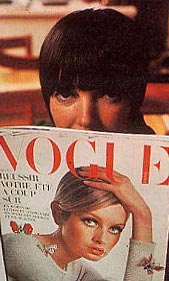 Petite, doll-like, with a frame of short dark hair around her face, Mary Quant first began designing clothes for herself and friends, "who did not want to grow up to have candy floss hair, stiletto heels and great boobs". Petite, doll-like, with a frame of short dark hair around her face, Mary Quant first began designing clothes for herself and friends, "who did not want to grow up to have candy floss hair, stiletto heels and great boobs".
Her early clothes indeed had a child-like appeal -- pinafores and tent dresses in bright colours, with a decidedly flat bust. She sold them from BAZAAR, a boutique opened in 1955 on King's Road, Chelsea, the street that became the parade ground for the fashionable young.
But her influence really became apparent in the next decade. In 1965 she launched the mini-skirt on a thunderstruck -- but then wildly enthusiastic -- world, and soon the 'Quant Look' could be seen throughout the world.
Mary Quant's exciting new ideas helped make London, rather then Paris, the centre of the fashion world in the 60's.
The young Welsh fashion revel did so much for exports that she was awarded the CBE. Soon, other designers followed her lead: now fashion was based not on haute couture but the high street, providing inexpensive clothes for the young.
The focus of the fashion world changed, too. John Stephens, the son of a Glasgow grocer, opened his first boutique in London's Carnaby Street in the late 50's.
Suddenly, swinging London - and Carnaby Street - became the place to see and be seen. By the mid-60's, this little-known backwater had become a Mecca for the fashion-conscious young.
|
|
The Beatles and The Mersey Sound
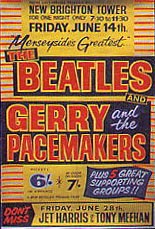 The 60's were a watershed for British popular music. For the first time, British groups dominated both the British and American charts, and could be heard on juke boxes all over the world. The 60's were a watershed for British popular music. For the first time, British groups dominated both the British and American charts, and could be heard on juke boxes all over the world.
To most people, 60's pop music means The Beatles, first and foremost. But their triumph was not simply an isolated expression of musical genius: it was built on the foundations of a 'beat' or 'sound' that had been thriving for years in Liverpool's steamy cellars.
The spirit of skiffle and rock-and-roll had lived on in Liverpool, nurtured by a steady diet of imported American music. By 1961, the port had some 300 beat groups, playing at clubs such as The Iron Door and, most famously, The Cavern.
Competition was hot and standards were high. Soon there was a definite 'Mersey Sound': a tough, chunky, rhythmic fusion of blues and country and western, with British gloss.
In January, 1963, the Mersey Sound made a national breakthrough. A band called The Beatles released their second single PLEASE PLEASE ME.
It shot to number one in the British charts and unleashed a mania for everything Liverpudlian. Fame followed for Gerry and the Pacemakers, Billy J Kramer and the Dakotas, The Searchers, the Swinging Blue Jeans and a phalanx of others.
|
The Mini
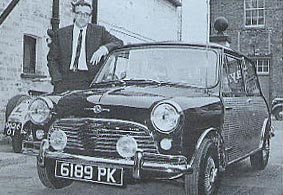
The Mini became not just a car but a fashion accessory, and stars such as Peter Sellers (pictured here) were quick to order customized models for themselves.
|
Compact, box like, with a tiny wheel base, the Mini appeared in August 1959 to climax a decade of British motoring design. It was a success from the start.
The brain-child of Sir Leonard Lord of BMC, who commissioned it, and of St. Alex Issigonis, the designer, the revolutionary Mini had a transversely-mounted front-wheel drive engine that was economical at 40 miles to the gallon, and it could carry five people at a squash.
It was a happy marriage of economy and refinement, and a worthy successor to the much-liked Morris Minor.
Priced at £497 for the standard and £537 for the deluxe models, the Mini managed to project a jaunty personality that was entirely classless.
It fitted in perfectly with the casual, happy-go-lucky atmosphere of the 60's, appealing as much to pop stars and peers as to housewives and postmen.
Marketed in a variety of shapes, sizes and colours it conquered many foreign markets, with the USA the only notable exception.
With only slight improvements made over the years, the ever-popular Mini continued in production until the very end of the 20th century.
|
Dr. Beeching and the Last Steam Train
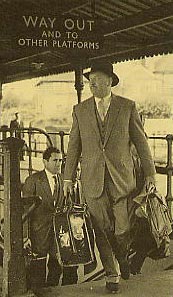
Dr. Beeching, seen here carrying a copy of his controversial report, outraged millions by modernizing British Rail, with effects that are still felt today.
|
For many the name of Dr. Beeching, appointed Chairman of British Rail in 1961, ranks high in the list of 20th-century vandals, who have tried to destroy civilisation as we know it.
In Dr. Beeching's case, it was the unpardonable sin of revamping the railways -- and in the process sacrificing the glamour and the romance of steam to the efficiency of diesel and electrification.
Dr.Beeching, ofcourse, maintained that the rapid growth in the number of cars in Britain -- from 2.25 million in 1951 to 8 million in 1964 -- and of freight-carrying lorries, meant massive competition for the railways.
His first response, in 1963, was to produce two reports on streamlining the railways. Then he acted.
Amid storms of protest, 'Beeching's Axe' fell on under-used branch lines all over the country. 2,128 stations were closed from the mid 60's on, and 67,700 jobs lost. Hitherto well-served communities had to use buses, cars and bicycles, with long-reaching consequences.
Increased efficiency also demanded the phasing out of steam locomotives in favour of diesel and electrification. The black day came on August 4, 1968, when the last scheduled steam service ran.
|
The Old Coins
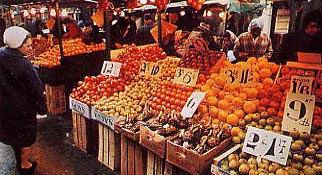
Decimal coinage was certainly logical, but shopping was no simple matter when some items were priced in new pence and others in shillings and old pence.
|
It is hard to believe that people in their 30s cannot remember the ubiquitous notation £.s.d., that they look blank at talk of 'half-a-crown' (2s 6d) or a farthing (¼d).
But the 1960's were indeed the last decade in which the solid clunk of shillings and old pence could be heard in the British pocket. The assault on the old coinage really got under way in 1961, when the farthing was declared obsolete.
By the mid 60's, there was talk of change, but few actually believed that the day would come when the meter did not take shillings and a gentleman could not pay for his bespoke suits in guineas.
By the end of the decade, however, it was obvious that decimalisation would have to come if Britain was to join the Common Market, whose monetary system was ruled by the decimal point.
With the election of Ted Heath's Government in June 1970, the die was cast. February 15, 1971 was set as D-Day - and the world of the little old lady at the corner shop was turned upside down.
There are still many who cherish a nostalgia for the old coins. But what we really miss most are the old prices!
|
Hippies
|
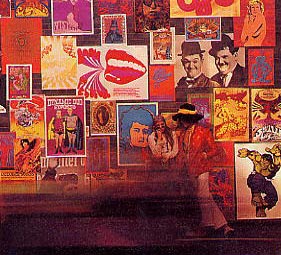
The Kaleidoscope patterns of hippie art and posters of political heroes and rock stars were essential decorations for thousands of university walls.
|
Drab formality and adherence to conventional values were anathema to the hippie-culture that flourished in the 'anything goes' atmosphere of the 60's.
The hippy code could not easily be broken down into a series of commandments, rather it was a reaction to what was seen as an addiction to money and the STATUS QUO.
It could be summed up in a few words: peace, love and 'getting stoned'.
In many cases, the youthful expression of hippydom went no further than long hair, beads, long dresses and hats, for girls; and of long hair, beards, beads and bell-bottomed jeans for boys.
Only a few really did 'drop out', but the countless weekend hippies made a lasting impact on tastes and more.
In 1967 'summer of love' in San Francisco's Haight-Ashbury district was the ultimate hippie experience. Pictures of the peaceful rebels, sitting around the park, joss-sticks in hand, or placing flowers in the rifle barrels of National Guardsman are now quaint but indelible images of 60's life.
In retrospect, it is clear that the experience had begun to turn sour by the 1969 Woodstock music festival, and money and materialism were making a comeback.
|
Mods and Rockers
|
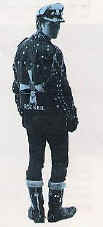
This rocker seems almost benign, but he might be very different on a Bank Holiday at a south coast resort, where, by tradition, mods and rockers fought pitched battles on the beaches.
|
It was perhaps inevitable that the 60's preoccupation with clothes and style would have its effect on the successors to the Teddy Boys of the 50's. Now many young people were either 'mods' or 'rockers'.
The notably neat 'mods' sported duck-green hooded Parkers. Give-away signs of their presence were the phut-phut of motor-scooters, the crooning of black soul singers, and the popping of pep pills.
But the roar of a 'ton-up' motor-cycle and the sound of rock-and-roll heralded a leather-jacketed 'rocker', the mod's deadly enemy.
With greasy hair, jeans and a tough guy attitude, he was a direct descendant of the 'Teddy Boy' and first cousin to the American 'Hell's Angels'
|
|
'Juke Box Jury' and 'Ready, Steady, Go'
Who would have thought that a TV show in which four people listened to a record and then rang a bell or sounded a hooter, would be one of the most popular ever?
Compered by David Jacobs, the BBC's JUKE BOX JURY was essential viewing for every teenager, and to be picked for the jury to predict whether a new release was a hit or miss was an accolade in itself.
In response, ITV's READY, STEADY, GO placed the studio audience thrillingly close to live groups as they mimed their records. The BBC fought back with TOP OF THE POPS, which lasted into the 90's.
|
Satire and 'TW3'
|
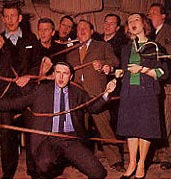
The TW3 team annoyed politicians so much that MPs talked of censoring the programme. But telephone calls to the BBC ran six to four in favour of satire.
|
Like ITMA before it, the acronym TW3 conjures up the humour of an era. This time it was satire -- a mocking, sometimes savage look at events and personalities of the 60's, in an irreverent TV programme written and presented by a group of graduates, who were so successful that, ironically, some became pillars of the very establishment they mocked.
TW3 had its beginnings in 1963 in BEYOND THE FRINGE, a small revue starring Peter Cook, Dudley Moore, Jonathan Miller and Alan Bennett. It was an instant success.
Five months later, Cook opened The Establishment, a club where young satirists and their friends mocked any and every figure of authority.
In the same month the satirical magazine PRIVATE EYE, was launched. It quickly took hold of the public imagination, and despite a history of law-suits, flourished.
The incestuous cross-fertilisation of satirical ideas continued the November premier of a weekly show on the BBC -- THAT WAS THE WEEK THAT WAS, or TW3. An eclectic concoction of sketches, political interviews, poems and songs, it grabbed both viewers and the headlines.
It was also the making of many of its young cast, none more so than its presenter, David Frost, who today interviews the government leaders he once pilloried.
|
|
Carry on Movies
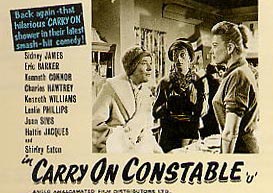 Mention the names of Sid James, Kenneth Williams, Charles Hawtrey, Hattie Jacques -- and you need go no further. Everyone recognises the stars of the Carry On films. Mention the names of Sid James, Kenneth Williams, Charles Hawtrey, Hattie Jacques -- and you need go no further. Everyone recognises the stars of the Carry On films.
From the first -- CARRY ON SERGEANT, in 1958 -- the humour was unsubtle, slapstick and sometimes blue, but producer Peter Rogers said "We're vulgar, but never crude". The public agreed, and the films became an institution.
Rollicking, rumbustuous and just a little rude, the Carry On films were popular favourites, and their stars became household names.
|
|
|


